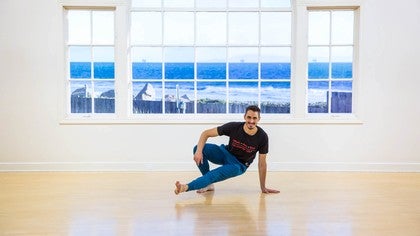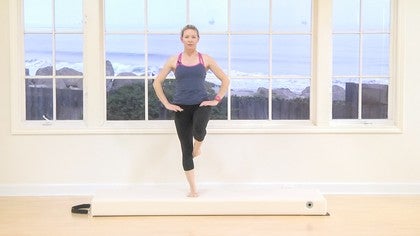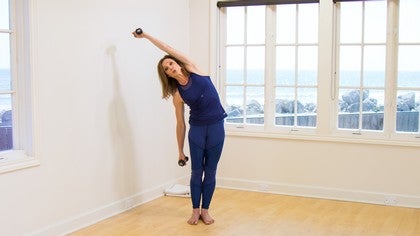Description
About This Video
Transcript
Read Full Transcript
Hi Guys. Uh, my name is Cornetto, um, physical therapist and movement practitioner from Spain. Um, we're gonna do a little warmup. Um, we're gonna use, uh, locomotion patterns in order to, to do this, this warmup, um, a locomotion is, uh, something really interesting and completely connected to our movement system. Basically, look, emotion means moving from point a to point B. So moving from one point to another, it comes from the Latin locals and the means place and motio that means, um, movement, motion. So, um, most of what we do in terms of, uh, movement, it implies some sort of locomotion. There's other things that we do like writing or eating that there are other motions that we use, uh, for, uh, survivors or for communication. But most of the things that we do is to, to locomote through, through a space, but sometimes they're exercises and working out is more about repetition.
It's about taking one movement and end in this movement. And then repeat again. So look, emotion in place, some sort of continuity. And that continuum is what frames and what the wires, our nervous system to, uh, get better embarrass skills. And Ability, uh, in, in order to move. So, so they're, their goal of this class is that you get so many ideas to start, um, get in a costume or familiarize with their, with their locomotion buttons that we, you can start thinking in this way of vision. And also that, uh, you can try to get new things to turn an exercise into, um, continuous motion or in our local motion because that is gonna enrich, uh, everything that you're gonna, uh, uh, influence into your nervous system. Okay? So we're gonna ask, started move in.
We're going to do 60 and exercises, um, and it's going to be bargained for it. So the idea is not that the movement not perfect is that you are practicing them, um, from time to time is gonna be some improvements, some, uh, enhancement in your strength and your mobility. But the most important thing, your nervous system will list will start to understand this continues, this continuity of movement. Okay? So we're going to start, uh, into this site. Uh, the first movement we are going to do is stand in. It's a very easy one. We're gonna just walk and we are adding just the little task. There's little dusk is touching the floor. So every time we'd do a step, we're gonna touch the floor. We do a step and we've got to touch the floor.
We're going to step like this. One of the things that you want to see here is that the door, Shaw is as upright as you can. Okay? Are Bright as you can. I'm going to rebid in this side. You go and listen and try and to touch. Trying to that, make sure that this is not happening.
Okay? So the chest wants to be up, wants to be up, wants to be up like that. Okay? So ribbit again,
You have to change the support that food all the time in order to live the pelvis and taking it back. Make sure you don't slide. You can slide if you like, but it's more interesting if you are go out of the floor and make a little little step. So the next one, so we have to, we're going to touch two hands every step.
We're gonna do a shoulder crawling. So now in this case we're going to be laying down like this and the same ideas. Earlier we were using this food and the contralateral hand. Now we're gonna use this foot contralateral shoulder. We opened the space and we take the pelvis back and now we change.
This is the shoulder that is supported. This is the food that is supported. This is where you open and go back. So you turn, change the food back sir. Change the food
So this, this, now this the shoulder, no, this and this shoulder, this and the shoulder and the shoulder. And again, the more continuous is the movement, the easiest and the more natural will be calm. So the next exercise we are going to do is similar, but we're going to add a little element of rotation. So the position we are going to start is this one is called uh, fishermen squad. Uh, their toes are tat so you are supported on the toes. This knee is facing this direction. This knee is facing this direction.
The way you build this movement is by dropping or leading this knee into the floor. When you touch the floor, this leg is like doing like a little strip into this and then you change and you sit again into the fishermen squat. So down sweep and chains down, shoot and see that shifts and changes. I'm going to repeat sometimes this is a, a little confusion. So 90 degrees between your hips, one is pointing in this direction, the other one is pointing in that direction. The knee is going down, one is down, you shrimp and churn the heel into the other state bone.
So make sure that the chest is up in this exercise and that you create in a little bit of depression when, when do you do it? So the next one is a four points crawling. So we're gonna use that a bit position, but we are not using the contact from, from the legs in, in any, sorry. So we are going to create a little tension between the hands that are going to push forward on the feet that I'm going to push back. Um, with the knees as close as possible to the floor. We're gonna Change, we're gonna lift contralateral food and here, make sure that the chest is a little bit higher than the pelvis. Um, that there is not as lot of rotations through the Belize.
It's okay if there's a little rotation that is normal. But try to control that rotation as much as possible. In the coming back. We're going to keep playing with it. Crap crawl. But now you can try to do both sides. Same size, sorry. At the same time, this is a little bit more tricky and it requires more rotational control.
So ipsilateral motion. Remember to push back, push back, push back, push. Okay good. The next one there, one of my favorite. So you can play with different motions, same side or contralateral side. You can move to the sides. Create a little spirals if you like. Okay, so really, really interesting one to come back. We can also do the four points quite a bit.
Crawling backwards. Again, same elements. Nice. Quite close. Chest, a little bit higher than the pelvis, not too much rotation, contralateral movement like this. So we have more for more patents to go. So next one is the is the frog. So it starts from a full squat position like this. You want to be as upright as you can and what you do is you, ah, length in your arms.
Until you fall and then you make a little step into a full squat again. So you go forward, stop and fall into the full squat for the forward, push forward. Use the little inertia to come back. Try to make yourself up right forward, fall
So now we turn to the other side. We use the support of this foot and slide back. So now this is the movement. We roll one side and so it's a good exercise to clean the floor of the studio. Okay, cool. Too much ago. Ah, there's one, it's a bit more complex but can you can modify, you can get your own, your own version of it. So we are going into this, uh, quite a bit position and we are going to take one foot into the, into the floor. Now give us this bridge.
So this hand consult lateral foot and we are going to take the leg in between like this. So now we are going to rich with this one and we're going to change to the other side like this. Now we are going to rich change food and kick through that back. Do you always try to get a little bit of space forward? When did you do it?
Remember this always contralateral movement like this and then writ and change to the other side. Cool. So one more thing in the last one. We are going to roll and come back into this conversation that you probably already familiar with. We had been following my videos, the fishermen, you should put the hand contralateral to the foot and then you take back. And what'd you do is to come back into this position again. So no, we role changed to the other position like this.
Support your hand, shake back and recover the leg. So your role change. If this is the food, this has to be the hand stand up and take back and you come back to this position.
No. You're going to stand, you're going to take the the back leg back and then come back into the uh, the squat. Show you a row and then change. Lex, stand up, take leg back. Make sure that you are here and you come back.
Okay,
So now it's time to practice. Make sure that you include the locomotion patterns and some continuity in your movement and have fun with this. Thank you very much.
Beginner Mat Workouts: 20-Minute Classes
Comments
You need to be a subscriber to post a comment.
Please Log In or Create an Account to start your free trial.




































